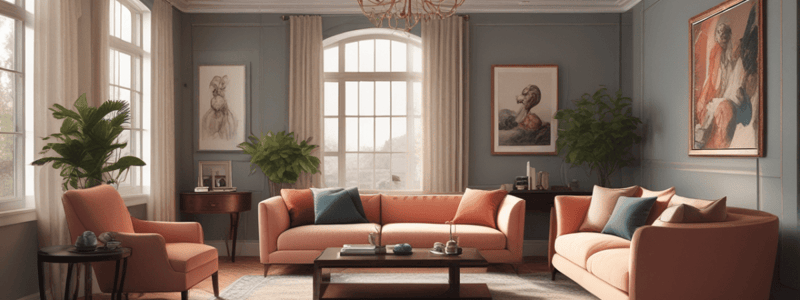Podcast
Questions and Answers
What is the primary goal of blending traditional and modern elements?
What is the primary goal of blending traditional and modern elements?
- To create a completely modern piece
- To honor tradition only
- To exclusively use traditional elements
- To find a balance between honoring tradition and embracing modernity (correct)
What is essential to understand when blending traditional and modern elements?
What is essential to understand when blending traditional and modern elements?
- Only modern elements
- Neither traditional nor modern elements
- The essence of both traditional and modern elements (correct)
- Only traditional elements
What should you do after identifying the core elements to integrate?
What should you do after identifying the core elements to integrate?
- Narrow down your choices to create a clearer vision (correct)
- Start blending the elements without a clear vision
- Disregard the traditional elements
- Abandon your vision and start over
What can help create a natural flow between traditional and modern elements?
What can help create a natural flow between traditional and modern elements?
Why is experimentation key when blending traditional and modern elements?
Why is experimentation key when blending traditional and modern elements?
What is an example of a traditional element?
What is an example of a traditional element?
What is an example of a modern element?
What is an example of a modern element?
What is the result of blending traditional and modern elements seamlessly?
What is the result of blending traditional and modern elements seamlessly?
What is the first step in finding a balance between traditional and modern aesthetics in liturgical dance?
What is the first step in finding a balance between traditional and modern aesthetics in liturgical dance?
What is the primary goal of incorporating modern elements into traditional liturgical dance?
What is the primary goal of incorporating modern elements into traditional liturgical dance?
How can you incorporate traditional movements from one culture into a contemporary framework?
How can you incorporate traditional movements from one culture into a contemporary framework?
What is the benefit of collaborating with artists from different disciplines in liturgical dance?
What is the benefit of collaborating with artists from different disciplines in liturgical dance?
What is essential to have a deep understanding of before combining traditional and modern elements in dance?
What is essential to have a deep understanding of before combining traditional and modern elements in dance?
What is one way to create innovative choreographic structures that honor tradition while embracing modernity?
What is one way to create innovative choreographic structures that honor tradition while embracing modernity?
What can expanding your repertoire bring to your choreography?
What can expanding your repertoire bring to your choreography?
Why is it important to understand the history and symbolism of traditional liturgical dance?
Why is it important to understand the history and symbolism of traditional liturgical dance?
What is the purpose of researching contemporary interpretations of liturgical dance?
What is the purpose of researching contemporary interpretations of liturgical dance?
Why is it important to stay true to your artistic voice when blending traditional and modern elements?
Why is it important to stay true to your artistic voice when blending traditional and modern elements?
What is the role of symbolism and metaphors in liturgical dance?
What is the role of symbolism and metaphors in liturgical dance?
What is the benefit of using technology and multimedia in liturgical dance?
What is the benefit of using technology and multimedia in liturgical dance?
What is a benefit of collaborating with other artists who specialize in traditional or modern disciplines?
What is a benefit of collaborating with other artists who specialize in traditional or modern disciplines?
What is the first step in experimenting with merging traditional and modern movements?
What is the first step in experimenting with merging traditional and modern movements?
What is the result of challenging traditional narratives and themes in liturgical dance?
What is the result of challenging traditional narratives and themes in liturgical dance?
What is an effective way to find a balance between traditional and modern aesthetics?
What is an effective way to find a balance between traditional and modern aesthetics?
What should you pay attention to when refining your choreography?
What should you pay attention to when refining your choreography?
Why is it important to continually reflect and refine your choreography in liturgical dance?
Why is it important to continually reflect and refine your choreography in liturgical dance?
Why is it important to engage with the community?
Why is it important to engage with the community?
What is one way to find inspiration for blending traditional and modern elements?
What is one way to find inspiration for blending traditional and modern elements?
What is the ultimate purpose of liturgical dance?
What is the ultimate purpose of liturgical dance?
What is crucial to retain in your choreography when blending traditional and modern elements?
What is crucial to retain in your choreography when blending traditional and modern elements?
What is the ultimate goal of incorporating modern elements into traditional liturgical dance?
What is the ultimate goal of incorporating modern elements into traditional liturgical dance?
What is required to find a balance between traditional and modern aesthetics in liturgical dance?
What is required to find a balance between traditional and modern aesthetics in liturgical dance?
Why is experimentation important when blending traditional and modern elements?
Why is experimentation important when blending traditional and modern elements?
What should you do when refining your choreography?
What should you do when refining your choreography?
What is the result of combining traditional and modern elements in liturgical dance?
What is the result of combining traditional and modern elements in liturgical dance?
What is the result of blending traditional and modern elements successfully?
What is the result of blending traditional and modern elements successfully?
Why is it important to reflect on the purpose of liturgical dance?
Why is it important to reflect on the purpose of liturgical dance?
What is the ultimate goal of finding a balance between traditional and modern aesthetics in liturgical dance?
What is the ultimate goal of finding a balance between traditional and modern aesthetics in liturgical dance?
Flashcards are hidden until you start studying
Study Notes
Combining Traditional and Modern Elements
- Blending traditional and modern elements requires a thoughtful and careful approach to achieve a seamless blend.
- Understanding both traditional and modern elements is crucial to integrate them effectively.
- Identifying specific elements to integrate, finding common ground, experimenting with fusion techniques, seeking inspiration, collaborating, and staying true to one's artistic voice are key strategies to blend traditional and modern elements.
Identifying Core Elements
- Identify specific traditional and modern elements to incorporate into your composition.
- Narrow down your choices to create a clearer vision for your piece and focus on blending these elements seamlessly.
Finding Common Ground
- Look for similarities or connections between traditional and modern elements.
- Find common ground in movement qualities, themes, emotions, or visual aesthetics.
Experimentation and Fusion
- Experiment with fusion techniques to discover new ways to blend elements.
- Combine movement sequences, music, costuming, or stage designs from different styles or cultures.
Seeking Inspiration
- Look beyond dance for inspiration from other art forms, such as visual arts, music, theater, or literature.
- Draw inspiration from techniques used in these fields to integrate traditional and modern elements.
Collaboration and Artistic Voice
- Collaborate with artists from different disciplines to gain new perspectives.
- Stay true to your artistic voice while blending traditional and modern elements.
Rehearsal and Refinement
- Rehearse and refine your work to ensure a seamless blend of traditional and modern elements.
- Seek feedback from other artists, mentors, or performers to refine your work further.
Strategies for Innovative Choreographic Structures
- Understand the essence of traditional dance forms and identify elements to preserve.
- Explore modern techniques, experiment with fusion, and incorporate technology and multimedia.
- Collaborate with artists from different disciplines, challenge traditional narratives, and experiment with spatial arrangements.
Balancing Traditional and Modern Aesthetics in Liturgical Dance
- Understand traditional elements of liturgical dance, including history, symbolism, and cultural significance.
- Familiarize yourself with modern dance techniques and research contemporary interpretations.
- Experiment with merging traditional and modern movements, seeking a balance through juxtaposition.
- Engage with the community, reflect on the purpose of liturgical dance, and continuously refine your work.
Studying That Suits You
Use AI to generate personalized quizzes and flashcards to suit your learning preferences.




